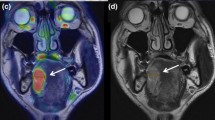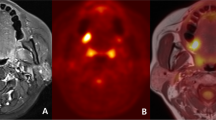Abstract
Objective
Integrated PET/MRI with [18F]FDG is advantageous in that it enables simultaneous PET and MR imaging with higher soft-tissue contrast, multiplanar image acquisition, and functional imaging capability without using fat suppression and gadolinium-based contrast agents (GBCAs). The aims of this study were to demonstrate the feasibility of [18F]FDG PET/MRI for assessing the extent of the primary tumor (T) in oral tongue cancer (OTC) based on the 8th edition of American Joint Committee on Cancer (AJCC) cancer staging system, and to compare the diagnostic accuracy between [18F]FDG PET/MRI and contrast-enhanced MRI (ceMRI).
Methods
18 patients with biopsy-proven operable OTC underwent preoperative regional [18F]FDG PET/MRI and ceMRI within 2 weeks. For [18F]FDG PET/MRI, rainbow-colored PET images were overlaid on the corresponding MR images. Tumor size and the depth of invasion (DOI) were visually measured on [18F]FDG PET/MRI and ceMRI. The size, DOI, and clinical T stage were evaluated using the final surgical pathology as the reference.
Results
Of the 18 OTCs, one was not detected by ceMRI due to metal artifacts from an artificial denture, and another due to superficial type (pathological DOI = 0 mm). Tumor sizes measured by ceMRI and [18F]FDG PET/MRI had significant positive correlations with the pathological size (r = 0.80 and r = 0.90, respectively), and DOIs measured by ceMRI and [18F]FDG PET/MRI had significant positive correlations with the pathological DOI (r = 0.74 and r = 0.64, respectively). The means ± SD of size (mm) were 20.4 ± 9.1, 22.9 ± 10.9, and 26.2 ± 10.0, and those of DOI (mm) were 7.1 ± 2.5, 6.9 ± 2.2, and 5.8 ± 3.2 for ceMRI, [18F]FDG PET/MRI, and pathology, respectively. A significant difference was observed in tumor size between ceMRI and pathology (p < 0.05), whereas no significant differences were observed between any other sizes, DOIs, or T stages. The accuracy for T status was 72% (13/18 including 2 undetectable cases) for ceMRI and 89% (16/18) for [18F]FDG PET/MRI.
Conclusions
Although shallow DOIs are often overestimated, regional [18F]FDG PET/MRI without fat suppression and gadolinium enhancement is comparable to and may be substituted for ceMRI in preoperative T staging for OTC patients, reducing metal artifacts and avoiding the adverse effects of GBCAs.





Similar content being viewed by others
Abbreviations
- PET:
-
Positron emission tomography
- MRI:
-
Magnetic resonance imaging
- [18F]FDG:
-
2-[18F]-Fluoro-2-deoxy-d-glucose
- GBCAs:
-
Gadolinium-based contrast agents
- ceMRI:
-
Contrast-enhanced MRI
- CT:
-
Computed tomography
- AJCC:
-
American Joint Committee on Cancer
- OCC:
-
Oral cavity cancer
- OTC:
-
Oral tongue cancer
- DOI:
-
Depth of invasion
- T:
-
The extent of the primary tumor
- TOF:
-
Time of flight
- PSF:
-
Point spread function
- OSEM:
-
Ordered subset expectation maximization
- SUV:
-
Standardized uptake value
- T2WI:
-
T2-Weighted imaging
- ANOVA:
-
Analysis of variance
References
Kubiessa K, Purz S, Gawlitza M, Kuhn A, Fuchs J, Steinhoff KG, et al. Initial clinical results of simultaneous 18F-FDG PET/MRI in comparison to 18F-FDG PET/CT in patients with head and neck cancer. Eur J Nucl Med Mol Imaging. 2014;41:639–48.
Lee SJ, Seo HJ, Cheon GJ, Kim JH, Kim EE, Kang KW, et al. Usefulness of integrated PET/MRI in head and neck cancer: a preliminary study. Nucl Med Mol Imaging. 2014;48:98–105.
Schaarschmidt BM, Heusch P, Buchbender C, Ruhlmann M, Bergmann C, Ruhlmann V, et al. Locoregional tumour evaluation of squamous cell carcinoma in the head and neck area: a comparison between MRI, PET/CT and integrated PET/MRI. Eur J Nucl Med Mol Imaging. 2016;43:92–102.
Schlittenbauer T, Zeilinger M, Nkenke E, Kreissel S, Wurm MC, Lell M, et al. Positron emission tomography-computed tomography versus positron emission tomography-magnetic resonance imaging for diagnosis of oral squamous cell carcinoma: a pilot study. J Craniomaxillofac Surg. 2015;43:2129–35.
Chan SC, Yeh CH, Yen TC, Ng SH, Chang JTC, Lin CY, et al. Clinical utility of simultaneous whole-body F-18-FDG PET/MRI as a single-step imaging modality in the staging of primary nasopharyngeal carcinoma. Eur J Nucl Med Mol Imaging. 2018;45:1297–308.
Tsujikawa T, Narita N, Kanno M, Takabayashi T, Fujieda S, Okazawa H. Role of PET/MRI in oral cavity and oropharyngeal cancers based on the 8th edition of the AJCC cancer staging system: a pictorial essay. Ann Nucl Med. 2018;32:239–49.
Amin MB, Edge SB, Greene FL, Byrd DR, Brookland RK, Washington MK, et al., editors. AJCC cancer staging manual. 8th ed. New York: Springer; 2017.
Lydiatt WM, Patel SG, O'Sullivan B, Brandwein MS, Ridge JA, Migliacci JC, et al. Head and Neck cancers-major changes in the American Joint Committee on cancer eighth edition cancer staging manual. CA Cancer J Clin. 2017;67:122–37.
Tan WJ, Chia CS, Tan HK, Soo KC, Iyer NG. Prognostic significance of invasion depth in oral tongue squamous cell carcinoma. ORL J Otorhinolaryngol Relat Spec. 2012;74:264–70.
Ling W, Mijiti A, Moming A. Survival pattern and prognostic factors of patients with squamous cell carcinoma of the tongue: a retrospective analysis of 210 cases. J Oral Maxillofac Surg. 2013;71:775–85.
International Consortium for Outcome Research in H, Neck C, Ebrahimi A, Gil Z, Amit M, Yen TC, et al. Primary tumor staging for oral cancer and a proposed modification incorporating depth of invasion: an international multicenter retrospective study. JAMA Otolaryngol Head Neck Surg. 2014;140:1138–48.
Xu C, Yuan J, Kang L, Zhang X, Wang L, Chen X, et al. Significance of depth of invasion determined by MRI in cT1N0 tongue squamous cell carcinoma. Sci Rep. 2020;10:4695.
Baba A, Hashimoto K, Kayama R, Yamauchi H, Ikeda K, Ojiri H. Radiological approach for the newly incorporated T staging factor, depth of invasion (DOI), of the oral tongue cancer in the 8th edition of American Joint Committee on Cancer (AJCC) staging manual: assessment of the necessity for elective neck dissection. Jpn J Radiol. 2020;38:821–32.
Ramalho M, Ramalho J. Gadolinium-based contrast agents: associated adverse reactions. Magn Reson Imaging Clin N Am. 2017;25:755–64.
Behzadi AH, Zhao Y, Farooq Z, Prince MR. Immediate allergic reactions to gadolinium-based contrast agents: a systematic review and meta-analysis. Radiology. 2018;286:471–82.
Ramalho M, Ramalho J, Burke LM, Semelka RC. Gadolinium retention and toxicity-an update. Adv Chronic Kidney Dis. 2017;24:138–46.
Huang SH, Chien CY, Lin WC, Fang FM, Wang PW, Lui CC, et al. A comparative study of fused FDG PET/MRI, PET/CT, MRI, and CT imaging for assessing surrounding tissue invasion of advanced buccal squamous cell carcinoma. Clin Nucl Med. 2011;36:518–25.
Kanda T, Kitajima K, Suenaga Y, Konishi J, Sasaki R, Morimoto K, et al. Value of retrospective image fusion of 18F-FDG PET and MRI for preoperative staging of head and neck cancer: comparison with PET/CT and contrast-enhanced neck MRI. Eur J Radiol. 2013;82:2005–100.
Hayashi K, Kikuchi M, Imai Y, Yamashita D, Hino M, Ito K, et al. Clinical value of fused PET/MRI for surgical planning in patients with oral/oropharyngeal carcinoma. Laryngoscope. 2020;130:367–74.
Murakami R, Shiraishi S, Yoshida R, Sakai J, Yamana K, Hirosue A, et al. Reliability of MRI-derived depth of invasion of oral tongue cancer. Acad Radiol. 2019;26:e180–e186186.
Nestle U, Kremp S, Schaefer-Schuler A, Sebastian-Welsch C, Hellwig D, Rübe C, et al. Comparison of different methods for delineation of 18F-FDG PET-positive tissue for target volume definition in radiotherapy of patients with non-small cell lung cancer. J Nucl Med. 2005;46:1342–8.
Orlhac F, Soussan M, Maisonobe JA, Garcia CA, Vanderlinden B, Buvat I. Tumor texture analysis in 18F-FDG PET: relationships between texture parameters, histogram indices, standardized uptake values, metabolic volumes, and total lesion glycolysis. J Nucl Med. 2014;55:414–22.
Acknowledgements
The authors thank the staff of the Department of Radiology and Biological Imaging Research Center, University of Fukui, for their clinical and technical support.
Funding
This study was partly funded by Grants-in-Aid for scientific research from the Japan Society for the Promotion of Science (19K08170, 19K09904) and the Takeda Science Foundation.
Author information
Authors and Affiliations
Corresponding author
Additional information
Publisher's Note
Springer Nature remains neutral with regard to jurisdictional claims in published maps and institutional affiliations.
Rights and permissions
About this article
Cite this article
Kanno, M., Tsujikawa, T., Narita, N. et al. Comparison of diagnostic accuracy between [18F]FDG PET/MRI and contrast-enhanced MRI in T staging for oral tongue cancer. Ann Nucl Med 34, 952–959 (2020). https://doi.org/10.1007/s12149-020-01526-y
Received:
Accepted:
Published:
Issue Date:
DOI: https://doi.org/10.1007/s12149-020-01526-y




